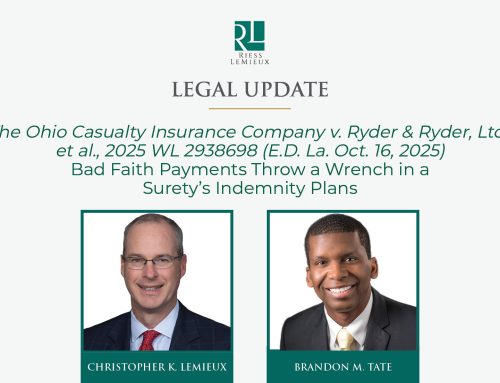The Louisiana Supreme Court recently issued a ruling clarifying the time period for insureds to assert bad-faith claims against their insurers that will have far-ranging effects on the insurance industry in the State of Louisiana. In Beverly Smith v. Citadel Insurance Co., the Court held that the prescriptive period to file suit alleging a first-party bad-faith claim against an insurer is ten years, not one year. While providing much-needed clarity regarding the rights of insureds to file suit against their insurers for bad-faith, the ruling will expose insurers to bad-faith claims long after the underlying insurance claim arises.
The plaintiff, Beverly Smith, filed suit against the defendant, Darlene Shelmire, and her insurer, GoAuto Insurance Company (GoAuto), as a result of an automobile accident on July 27, 2010. At trial, the district court found in favor of the plaintiff for an amount in excess of the insurance policy limits. GoAuto appealed. Shelmire did not appeal. The court of appeal affirmed the district court’s judgment. Following the judgment, Shelmire assigned her rights to pursue a bad-faith claim against GoAuto to the plaintiff.
Ms. Smith, as the assignee of Shelmire’s bad-faith claim, filed suit against GoAuto for a bad faith under La. R.S. § 22:1973(A) and the jurisprudentially recognized duty of good faith. GoAuto filed an exception of prescription arguing the bad-faith claim is a delictual action and subject to one-year prescriptive period. The plaintiff opposed the exception on the grounds that bad-faith claims are contractual and subject to a ten-year prescriptive period. The district court overruled the exception of prescription, finding that the duty owed by the insurer to its insured is a contractual duty and therefore subject to a ten-year prescriptive period. GoAuto applied for a supervisory writ to the court of appeal, which denied the writ application. Subsequently, GoAuto filed a writ with the Louisiana Supreme Court, which was granted.
The Court addressed two preliminary matters: (1) GoAuto’s argument the Ms. Smith did not have a cause of action; and (2) Ms. Smith’s argument that the court need not reach the issue of prescription because it did not apply in this case. The Court rejected both arguments, finding (1) Ms. Smith had a cause of action that was a permissible assignment of rights under Article 2642 of the Louisiana Civil Code; and (2) the issue of prescription must be addressed because Ms. Smith’s suit was not timely under a one-year prescriptive period.
The Court then addressed the prescriptive period for first-party bad-faith claims against an insurer. The Court observed that all personal actions are subject to a prescriptive period of ten-years and delictual (tort) actions are subject to a liberative prescription of one year. The major distinction is that the former flow from a breach of a contractual duty and the latter flow from the violation of general duty owed to everyone. Thomas v. State Employees Grp. Benefits Program, 05-0392 (La. App. 1 Cir. 3/24/06); 934 So.2d 753.
In general, an insurer owes a duty of good faith and fair dealing to its insured, which is codified in La. R.S. § 22:1973. However, the Court recognized that an “insurer’s duty of good faith owed to its insured under La. R.S. 22:1973 does not exist separate and apart from an insurer’s contractual obligation. The duty of good faith is codified . . . but this duty is an outgrowth of the contractual and fiduciary relationship between the insured and the insurer [whose] duty emanates from the contract between the parties.” Thus, the Court ultimately found that the insurer’s bad faith is a breach of its contractual obligation, which is a personal cause of action subject to a prescriptive period of ten years.
The Court further supported its decision by noting that its holding falls in line with the jurisprudence in state and federal courts. The Court cited multiple cases applying a ten-year prescriptive period to bad-faith claims against an insurer. Although the Court recognized that there are some outlier decisions, the weight of jurisprudence addressing the issue favors the application of a ten-year prescriptive period. Furthermore, the Court held that previous rulings did not address the prescriptive period for bad-faith claims, nor did earlier cases seek to ascertain the nature of the insurer’s duty relative to a first-party bad-faith claim.



